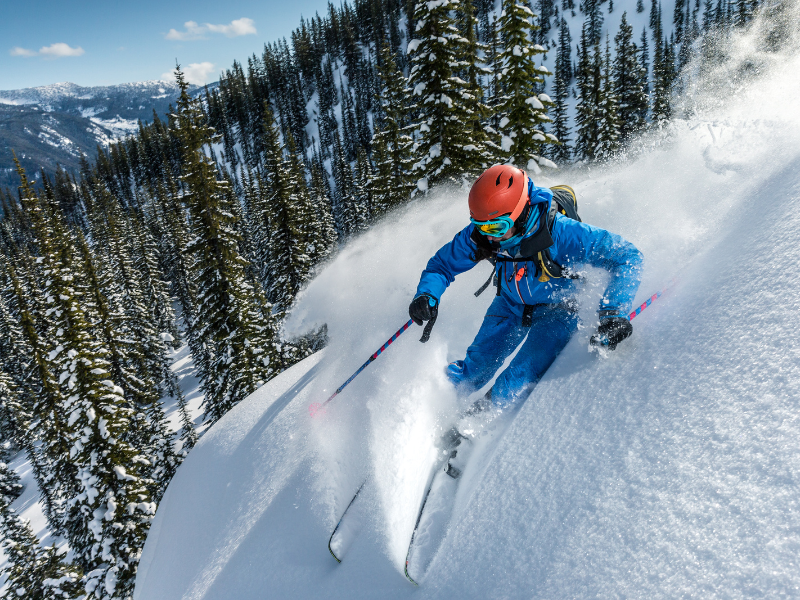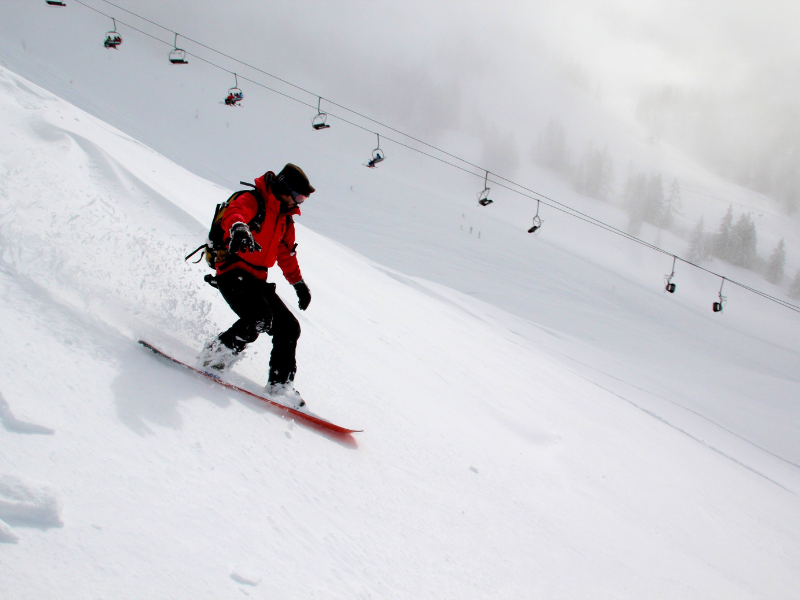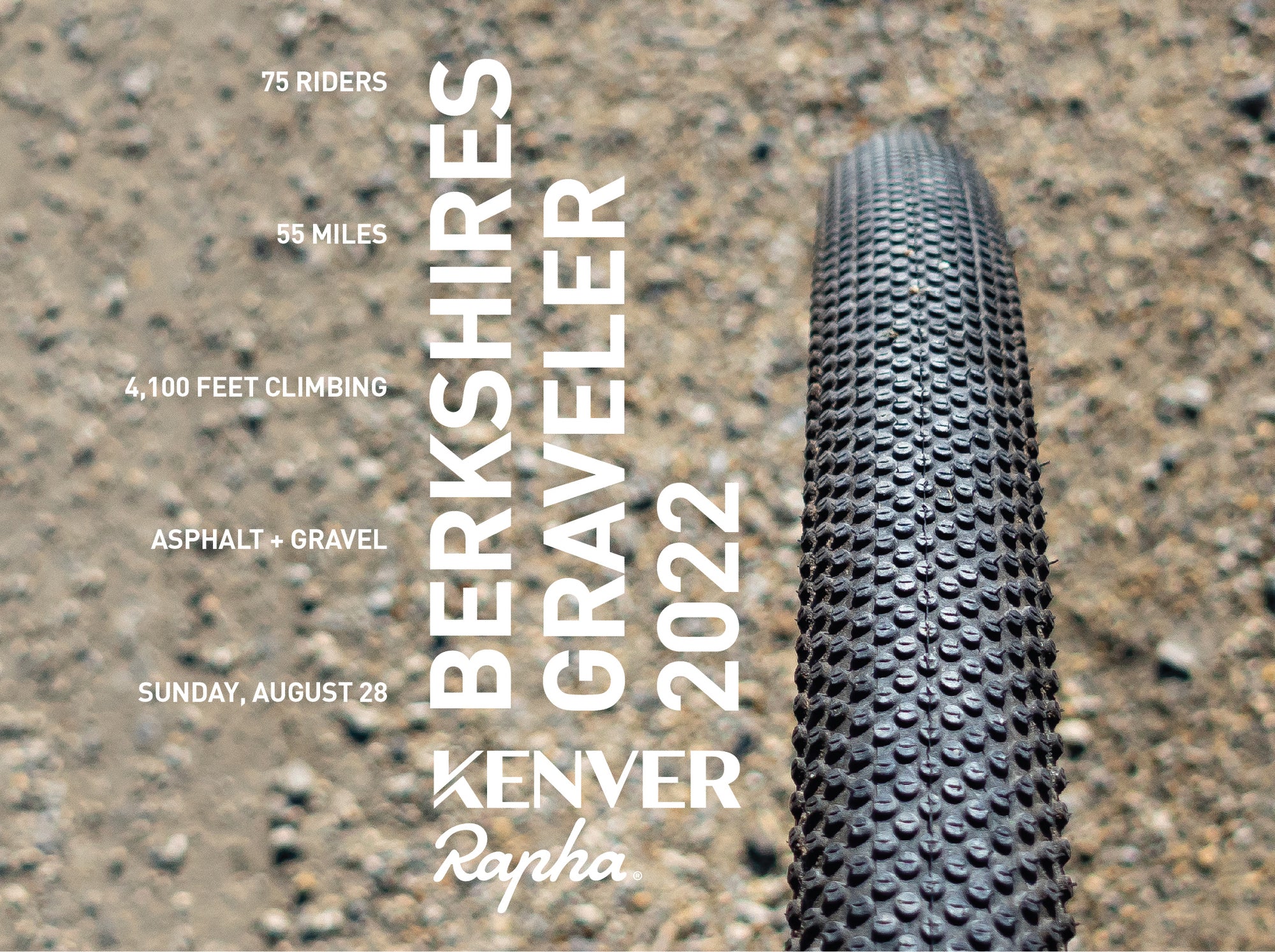So, you're about to hit the slopes for the first time and want to see if your "normal" coat will do the job. I first went skiing 17 years ago and had the same question. But for the past 7 years, I've been answering that question for customers at Kenver, especially as the season kicks off. This is what I tell them.
Regardless of experience level, wearing a "normal" coat while skiing or snowboarding is highly discouraged. A "normal" coat, or a winter coat, is only designed for warmth, whereas a ski jacket is built for durability, water and wind resistance, breathability, and warmth.
Skiing and snowboarding are the equivalents of exercising all day at 25mph in the snow, where temperatures hover around freezing. So staying warm is just one of five functions your jacket needs to handle; here's the inside scoop on each.
5 Reasons You Shouldn't Wear a "Normal" Coat On The Slopes
If this is your first time skiing or snowboarding, you're going to have a blast, but if nobody's told you yet, you are going to fall. A lot. On your face, on your butt, on your side - you'll fold in places you didn't know you could.
This is part of the improvement process, and it happens to everyone - beginners and 40-year vets alike. In addition to the obvious climate conditions, falling is one of the main reasons a "normal" coat won't suffice on the slopes; it simply isn't designed to take that kind of impact or have that level of wind or snow on it.
When it comes down to it, a jacket that performs well on the slopes has a completely different set of fabrics and construction than your typical winter coat. The materials are far tougher, and the build is more compartmentalized and intentionally layered than your average parka.
That's the power behind a ski and snowboard-specific jacket.
1. Durability - Your "Normal" Coat Won't Make It
Again, you're going to fall at some point during your ski day. And if you slide out there in your $500 casual winter coat, you might need to buy a new winter coat before lunchtime.
A ski or snowboard jacket can take a beating without ripping or tearing. This isn't limited to the impact from falling either; snagging on a branch, or even a rogue ski pole in line at the lift would rip through a standard winter coat.
Plus, some coats just weren't meant to get wet, and while there's a whole separate topic dedicated to waterproofed jackets, if the wrong material on your average coat gets wet, that could impact its longevity.
So instead of investing in a new regular coat because you ruined your current one on the slopes, consider a ski or snowboard-specific jacket that can take the beating you're about to put it through.
With these jackets becoming pricier by the year, get one that lasts as long as possible.
Look at jackets made from either nylon or polyester treated with a DWR (Durable Water Repellency) coating. I usually go through a ski jacket like this every 7 years, and I put a lot of miles on each of them.
Whether you plan on skiing either once a year, or multiple times a year, a coat that holds up to ski fails, and there will be plenty of those, will come in handy in other scenarios as well.
2. Waterproofness - Anything That Touches Snow Gets Wet
Your standard winter coat, one built for warmth, likely isn't waterproof. Even if it's water-resistant, that level of protection won't hold up to being submerged in the snow the way a ski jacket needs to.
While it would be nice if we could all just stay on top of the snow at all times, this simply isn't reality. When you do fall, it's not like you float on the top - in some places you could sink a couple of feet or more.
But let's say you're a ski god, and you manage to stay on your feet all day, you're still going to get wet. If the temperature is anywhere below freezing, that moisture is going to turn to ice quickly, and it doesn't take long before it leeches through your clothes and affects your core temperature.
Even the warmest winter coat won't be able to help you in this situation, you'll need a waterproof jacket. You have a couple of options to consider here.
If you plan on skiing only once a year, a jacket with its own waterproofing technology is sufficient. If you plan on skiing every weekend, you'll want something made with heavy-duty waterproofing technology.
The most prominent technology in waterproofing is Gore-Tx. The technology’s fabric membrane is 20,000 times smaller than a regular water droplet. I've had plenty of Gore-Tex gear, from ski jackets to hiking shoes, and they've never disappointed me.
3. Breathability - A Normal Coat Will Make You Sweat
Skiing is one of the best forms of cardio there is. You might not think so when you're trudging up a hill, or even just digging yourself out of a pit every half hour, but you'll be huffing and puffing at some point during the day. You're going to sweat as a result.
In fact, it can be a delicate dance with body temperature - where you're in a frigid temperature, but might stay warm from the sunshine if it's out, and might even get overheated if you're layered too heavily or wearing the wrong materials.
A coat built to keep you warm primarily does so by trapping your body heat in - and being as efficient as possible at retaining it - sort of like running the heat in your house - your coat acts as your exterior.
And when you add in the fact that skiing is downhill cardio, plus you're wearing extra layers to insulate yourself from the cold, it's easy to see how quickly you can break a sweat.
Your standard coat isn't going to allow your body to breathe the way it needs to, which means you're going to be stuck in your own sweat all day, and that's just as bad as being cold.
Breathability is overlooked, but it's the connective tissue of keeping a stable temperature all day, which is critical.
I'd recommend three things here.
- Vents: The first is to look for a jacket with vents - underarm vents/pit zippers are common - that you can open up to let your body breathe. If you're one of those people that sweats pretty easily, this feature's a must. It's pretty standard, but if you're new to this type of apparel, just double-check.
- Fabrics: A good ski or snowboard jacket has a waterproof and breathable membrane like Gore-Tex or eVent (yep, Gore-Tex is back again) that will keep you dry from the outside snow and wetness, but also allow your body to vent sweat and moisture from the inside.
- Layers: Make sure the materials you're wearing under your jacket will wick moisture away from your body, like merino wool or synthetic fabrics.
Honorable mention here is to think about weight - finding a light coat can do wonders for not overheating.
4. Wind Protection - Your Coat Can't Handle The Wind
When heading down the mountain, keeping the wind off your body will define the fitness of your insulation. Your regular coat just wasn't made to handle the high winds you'll encounter skiing or snowboarding. The wind will tear right through it.
And trust me, it can get cold.
If you don't have a good windproof layer, you'll be shivering all day, no matter how many layers you have on. The moisture that you will inevitably create from sweating in your regular coat, or the layer of moisture on you from the snow will freeze from the wind. And your day is ruined at that point, but it can actually get more serious than that.
Hypothermia and frostbite, from the combination of moisture and wind, are far more common than you think. While cross-country skiing is far different than downhill skiing or snowboarding, the incidence of hypothermia is estimated at 20%.
Cross-country is far more cardio-focused, but that same study included skiing and snowboarding and found that nearly all snowsports have a high incidence of frostbite and hypothermia.
Hypothermia caused by wind is no joke, so if you want to protect yourself from wind, look for one that provides coverage to keep your skin away from the wind. Most jackets that are waterproof do tend to have wind protection technology included.
5. Warmth - The Crown Jewel of Snow-Grade Jackets
Keeping warm is the most critical part of looking for a ski or snowboard jacket. Not having enough insulation can shorten a ski trip to one run down the mountain. There are two different types of methods for having a warm ski experience. You can get a ski jacket that already has insulation, or you can go for what is called a three-layer system.
A three-layer system is one where you have a base layer, like a thermal shirt, a mid-layer, an insulated jacket, and then a shell layer, the waterproof/windproof jacket.
I use a three-layer system for insulation, but if you want a jacket with everything, I recommend going with an already-insulated one. One advantage of the three-layer system is you have more flexibility to control your temperature if needed.
You certainly need a basic level of insulation for warmth, but I tend to think of it as the goal and output of all the other features doing their jobs well.
By now, you've probably figured out that warmth is mostly the output of pulling all the other levers.
That is, Warmth is the byproduct of having a jacket that is flexible with your body temperature changing, your coat getting wet then dry, and then getting extremely cold from wind and freezing.
What Is A "Normal" Coat Anyways?
I know, I've used this term a lot throughout the article, and I probably shouldn't have waited this long to define it, and it's overdue because I've made the term up. But here's what I mean.
A "normal" coat is one that you would wear out in the city. It's not made for any specific activity, or any kind of harsh weather condition. It generally doesn't have any waterproofing technology or insulation other than what you get from the materials used.
Which means it's not meant to get wet or insulate you from the cold. It's not meant to keep the wind off your body, and it probably won't have a hood.
Now that we know what a "normal" coat is, let's cross the following off your ideas list of coats to wear on the big snow trip - don't wear the following coats to ski or snowboard.
1. Wool Jackets Equal Heavy Jackets
Wool jackets will definitely keep you warm in winter but would be a disaster while skiing. Suppose you wore a wool jacket while skiing. The coat would most likely not make it through your first trip on the mountain.
Sweat and snow would drench the fabric inside and out.
This is a little bit too geeky, but I'll share nonetheless. Wool is water-resistant and moisture wicking, but it still absorbs moisture. That means the moisture is going to get pulled into the center of the fabric, but it won't go through to your layers underneath.
And Holy Hell it would be heavy, plus that's going to be quite a few trips to the dry cleaner, unless you want to shrink your wool jacket in the dryer.
2. Parka Jackets, Great If You Want To Fall All Day
Parka jackets are nice to have in winter. Not only are they fashionable, big wink at Canada Goose, but they will also bundle you up to keep out the cold. However, parka jackets would slow you down.
And at the same time, you would lose the maneuverability required to ski or snowboard. Which can be pretty dangerous Leave this one at home if you are heading out for a ski trip.
3. Bomber Jackets - Not The Bomb
Bomber jackets are great for getting around town if you only stand outside for a few minutes, or if you want to play pretend Maverick.
With that said, they wouldn't hold up during a full ski day. You would start to feel cold after 15 minutes of high-intensity runs, and it would not keep you warm throughout the session. On a nice winter day, use your bomber. On the mountain, use a warmer efficient jacket.
Ditch The "Normal" Coat - Invest In A Ski Or Snowboard Jacket
I hope this article has helped clear up any confusion on what kind of coat to wear skiing or snowboarding. It's a big investment, but now that you know the five most important functions of a ski/snowboard jacket, you're ready to make a good decision.
Whenever JC at Kenver gets asked about wearing "normal" apparel skiing or snowboarding, he always responds, "...dress for the weather of the location you're skiing. If you plan to ski the east coast, you want a jacket that will keep you dry and warm, because the snow here is wet and cold."
Solid advice. Now that you've got the knowledge, it's time to grab the right jacket.



